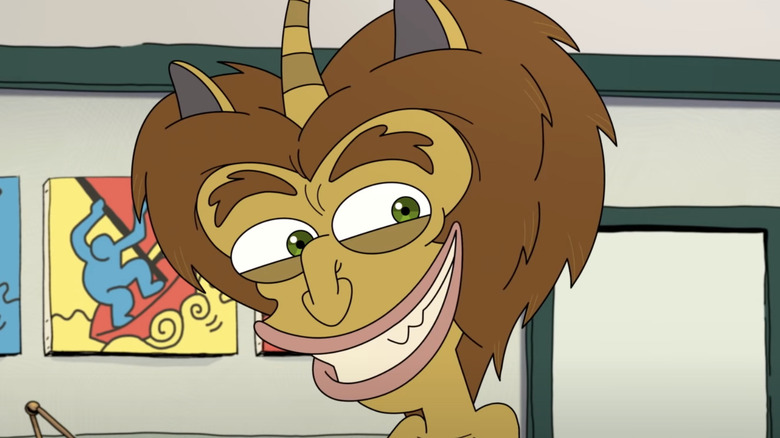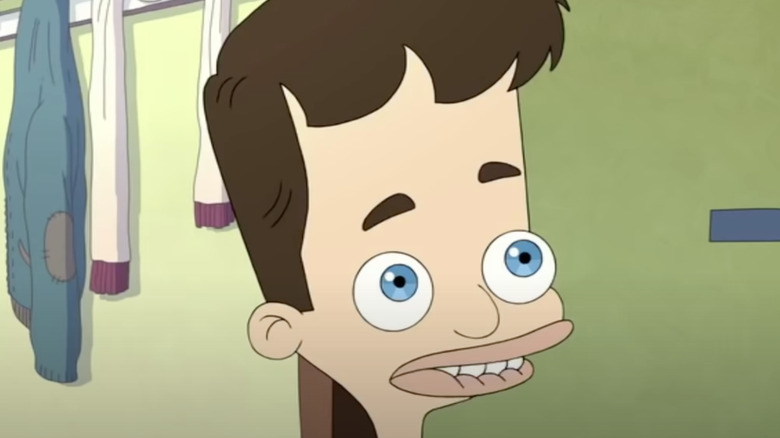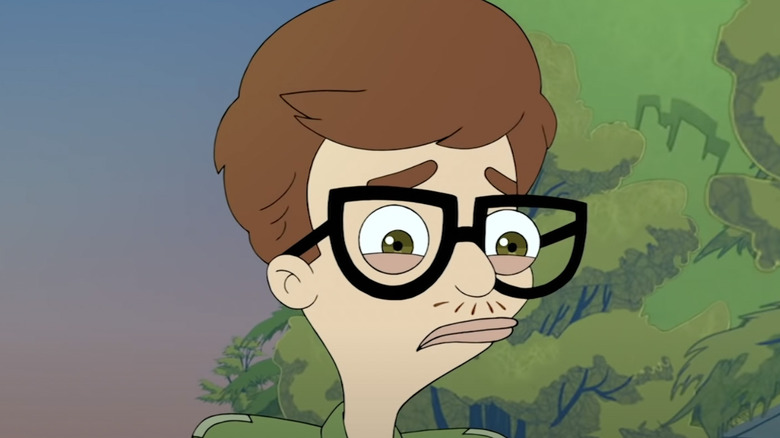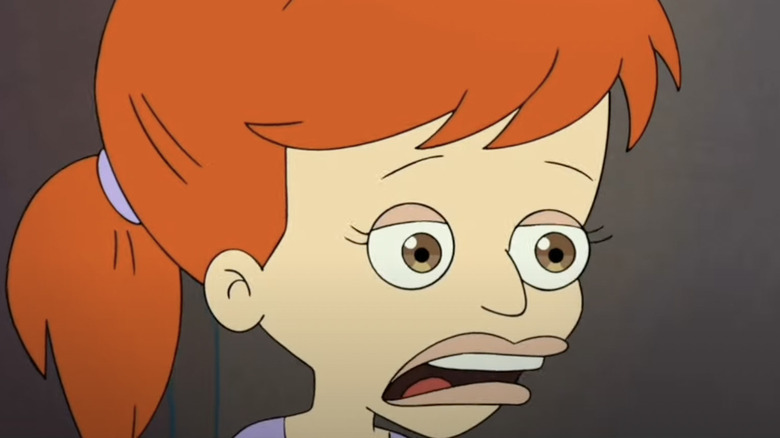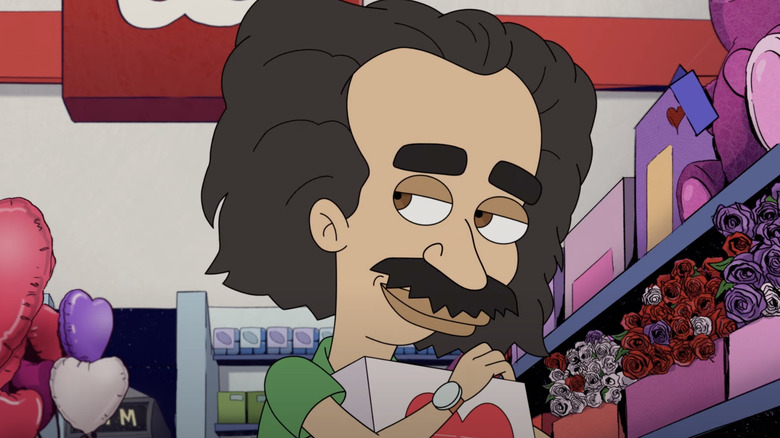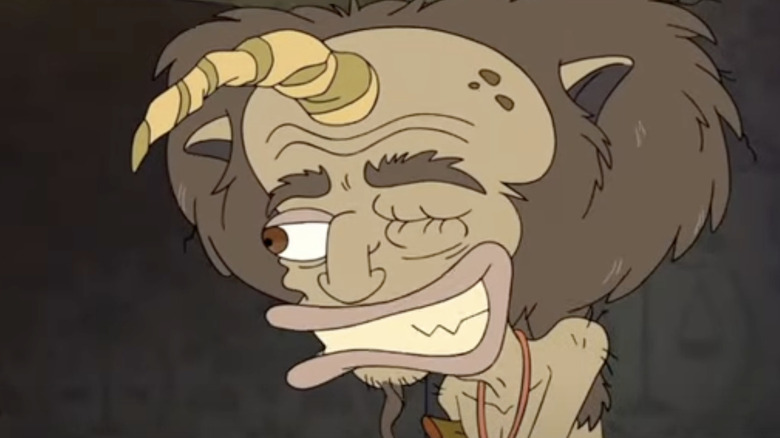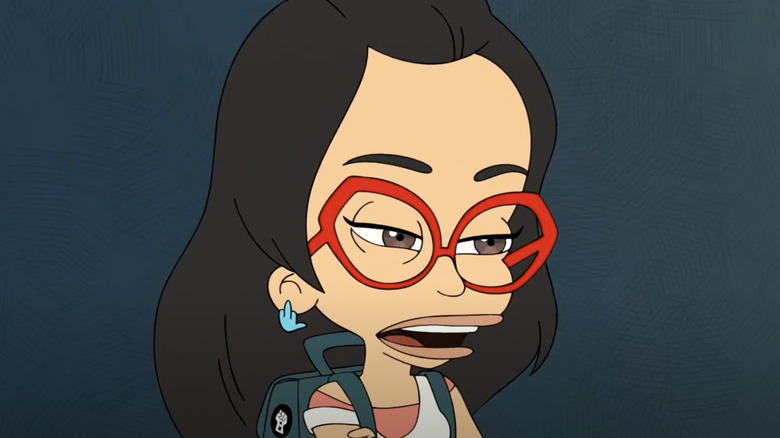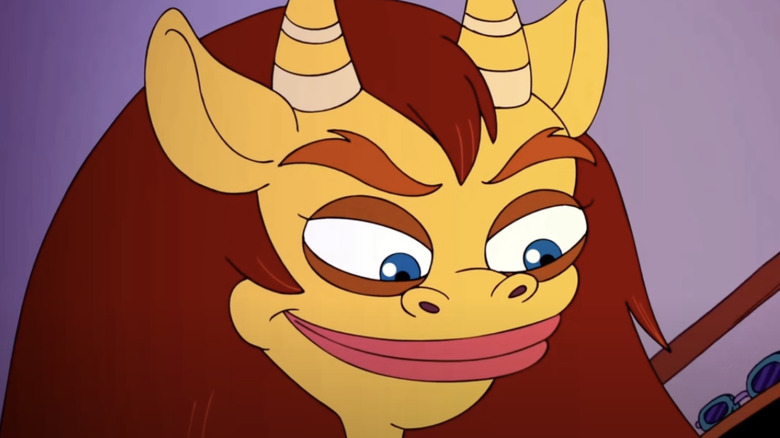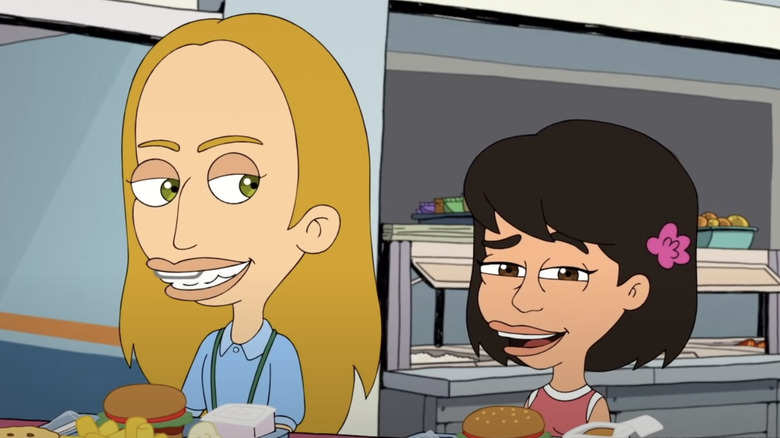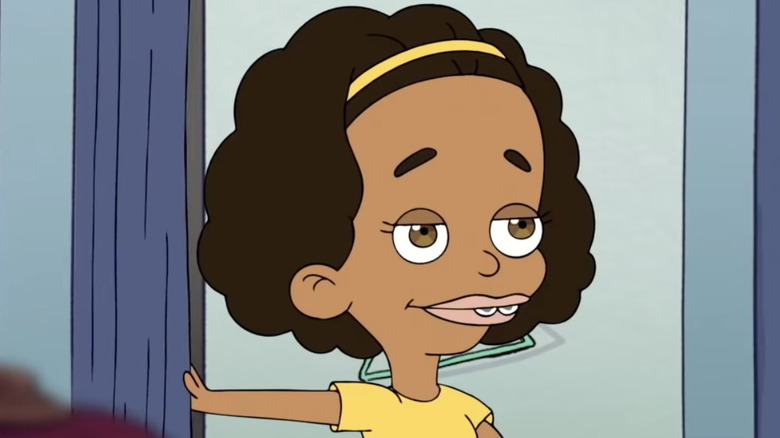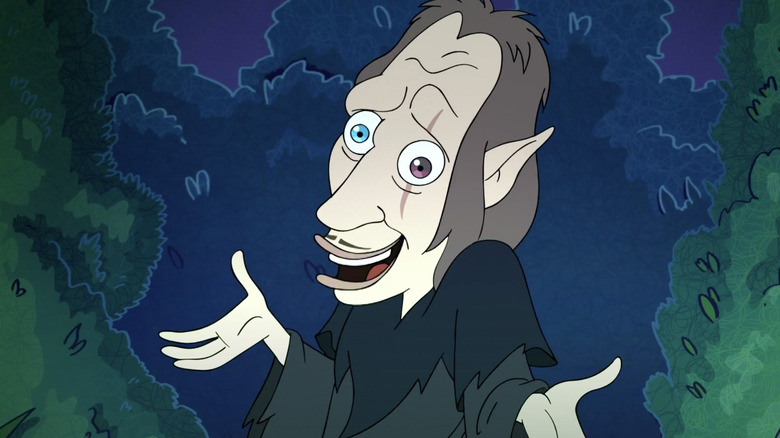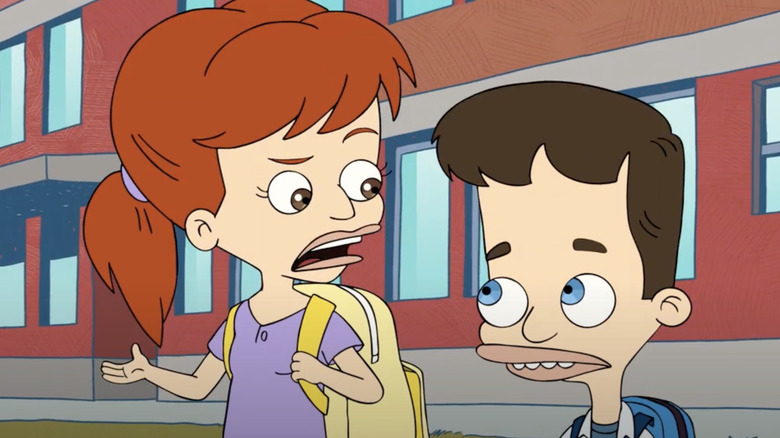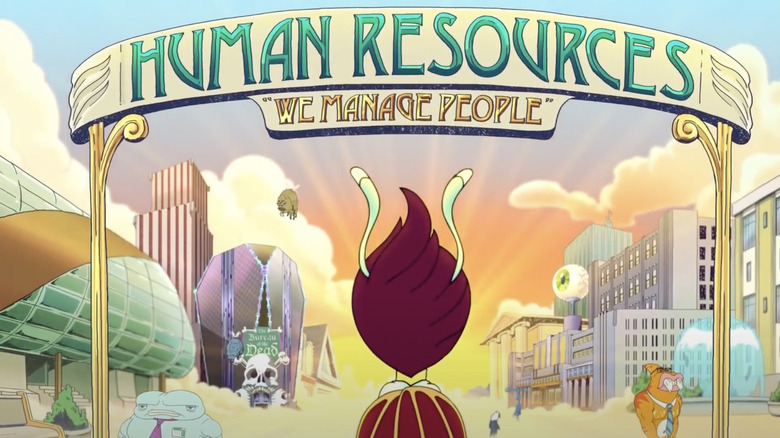The Untold Truth Of Big Mouth
Adolescence, or puberty, with all of its abrupt, painful, and awkward changes forced upon the human body, brain, and libido, is a universally relatable experience. It's gross or weird for just about everyone, which is why "Big Mouth" has proven such a smash with critics and audiences. The provocative Netflix series, set in and around a suburban New Jersey junior high features a large cast of major comedians voicing kid characters dealing with the joys and pitfalls of growing up (mostly the latter).
There's slow-to-bloom Nick (co-creator Nick Kroll), anxious and guilty Andrew (John Mulaney), actively self-actualizing nerd Missy (Ayo Edebiri), and hormone-crazed Jay (Jason Mantzoukas). And speaking of hormones, the kids are beleaguered by their personal hormone monsters, physical and grotesque manifestations of their own psyches who unfailingly give them terrible advice.
"Big Mouth" offers a tricky mix of empathy, relatability, body positivity, and some of the most audacious plots and dialogue ever heard on television. Here's the story of how "Big Mouth" grew up.
How Nick Kroll came up with the idea for Big Mouth
According to The New York Times, Nick Kroll's initial "Big Mouth" idea came during an outbreak of eczema, a skin condition from which he has suffered since his youth. He wrote some jokes about it for his stand-up act and shared them with friend Jason Mantzoukas (who would go on to play Jay on "Big Mouth"), who told him to "dig deeper" because he was "on the cusp of something interesting." Kroll reflected and found a parallel to puberty, like how he was well into adulthood and didn't have full control over his body — just like when he was about 12 or 13.
Around that time, Kroll's childhood best friend Andrew Goldberg, who, like Kroll, also went into comedy, writing for "Family Guy," pitched him a very skeletal premise, which he'd thought up with writing team Mark Levin and Jennifer Flackett, his former bosses. "The three of them came to me and said, 'What about a show about two guys in middle school and we'll make it animated?' and it sounded like a great idea," Kroll told Vulture.
They developed the idea built around the junior high dynamic between Kroll and Goldberg. "He hit puberty very early, I was a late bloomer," Kroll told NowThis Entertainment. Kroll voices Nick Birch, inspired by young Nick Kroll, while John Mulaney plays Andrew Glouberman, the "Big Mouth" version of Goldberg.
How Big Mouth went from an idea to a series
"Big Mouth" is a big show, full of big emotions, big musical numbers, and a big cast of characters. In its very first iteration, it was a very small and humble affair. "We made, like a little pencil test, a very simple two-minute cartoon, very presentational in style," Kroll told NPR's "It's Been a Minute with Sam Sanders." To voice the characters, Kroll just asked friends and colleagues to do it as a favor. "I called Maya [Rudolph] and Fred Armisen and Jenny Slate and Jordan Peele to record voices on — basically onto their phone for us to use in the presentation."
Kroll and associates pieced those voice recordings together with the crudely animated and short pilot presentation, and showed it to Netflix, which ordered it to a full series. Not totally expecting everyone to remain on board, Kroll was delighted when all those stars "agreed to be a part of the show."
Big Mouth is very much based on true stories
Not only did "Big Mouth" creators Nick Kroll and Andrew Goldberg base the characters of Nick and Andrew on their younger selves and their awkward, humiliating junior high years, the duo and other writers for the show pulled whole episode plots straight from their real lives. "I was pantsed when I was in the seventh grade. Everything came down in front of my childhood crush," Kroll told NowThis Entertainment, referencing a mortifying "Big Mouth" moment. "A friend of ours got her period for the first time on a class trip to the Statue of Liberty," he added, which happened to Jessi on the series. Another childhood acquaintance admitted to physically experimenting on his pillow, according to Vulture, which became the inspiration for the Jay character.
The Season Two episode "What is it About Boobs?" finds Missy and Jessi going to a Korean spa, where nudity is both required and celebrated, and the often self-conscious young women sing a disco empowerment anthem called "I Love My Body." "Big Mouth" co-creator Jennifer Flackett told Decider that she'd previously taken her teenage daughter to a spa, and she loved the vibe of body positivity. "I really looked at it through her eyes thinking the exact same thing," Flackett said. "If I had seen that when I was younger that would've been so impactful."
Big Mouth is loaded with references to its voice actors
The bulk of the "Big Mouth" voice cast consists of some of the best-known and most influential comedians and comic actors of the past decade, and the show's writers like to bury referential Easter eggs to those performers' other works. During a trip to New York City on a field trip, the kids walk by a billboard advertising "The Oh, Hello Show," a Broadway comedy about menacing old-school New Yorkers Gil Faizon and George St. Geegland, portrayed by "Big Mouth" duo Nick Kroll and John Mulaney. In the same episode, there's a brief shot of another billboard advertising a horror movie called "Stay Out" — an allusion to "Get Out," written and directed by Jordan Peele, who voices the ghost of jazz legend Duke Ellington on "Big Mouth."
The second season of the series prominently features David Thewlis as the Shame Wizard, and in the episode "Smooch or Share," a hormone monster calls the character "the floating guy with the Harry Potter accent." That's a nod to how Thewlis played Professor Remus Lupin in five "Harry Potter" adaptations. And among the many characters Kroll voices is the pathetic and creepy Coach Steve, who is simply a more absurd and extreme version of Ref Jeff, a character he popularized on his Comedy Central sketch series "Kroll Show."
Big Mouth is barely ever censored
Perhaps no show about adolescence and junior high has ever been as frank, filthy, and provocative as "Big Mouth" has because historical forms of content delivery were more subject to censorship, and producers had to answer to advertisers. Netflix isn't subject to the regulations of broadcast TV or outside companies footing the bill and calling the shots because it's a subscription-oriented online streaming service. As such, Netflix offers "Big Mouth" writers and producers a very high level of autonomy and creative control, allowing the show's staff to word-police its scripts. "At every table read, there'd be one joke where the audience is like, 'Uhhh," co-creator Andrew Goldberg told TheWrap. "And then we'd know. And we know if we hadn't done that, then we haven't done our jobs. We practice a lot of self-censorship."
Nevertheless, Goldberg could only recall one time when Netflix forced "Big Mouth" creatives to cut a joke. "It was a very well-rendered, graphic shot of a thermometer" emerging out of a urethra, Goldberg said. "And even that, we were 50-50 on whether or not we liked it. They were like, 'We don't think so,' and we were like, 'Yeah, we don't think so either.'"
Big Mouth had to apologize
One time, a bit made it past the table read and Netflix authorities ultimately resulted in a public apology. In a 2019 episode, Ali (Ali Wong) explains that she's pansexual, and how that identity differs from bisexuality. "It's like, some of you borings like tacos, and some of you like burritos. And if you're bisexual, you like tacos and burritos. But I'm saying I like tacos and burritos, and I could be into a taco that was born a burrito, or a burrito that is transitioning into a taco, comprende?"
However, in trying to be inclusive and sensitive, "Big Mouth" writers got it all wrong; according to Vulture, members of the LGBT community pointed out that bisexuality isn't exclusive of nonbinary gender identities. "We missed the mark here with this definition of bisexuality vs. pansexuality, and my fellow creators and I sincerely apologize for making people feel misrepresented," Goldberg said on Twitter.
How a mundane pronunciation became a Big Mouth viral sensation
In 2020 and 2021, Maya Rudolph won the Emmy Award for Outstanding Character Voice-Over Performance for her work as Connie the Hormone Monstress on "Big Mouth." Her performance as the wildly over-the-top, emotionally-driven, libidinous, transgressive, and aggressively persuasive personification of puberty involves a unique, velvety method of speech, with some words almost arbitrarily exaggerated and drawn out for comic effect. That technique fully comes out on how Rudolph-as-Connie says the words "bubble bath," and there's so much going on there that it became a much-talked about or even viral sensation, according to the podcast "Conan O'Brien Needs a Friend."
On that podcast, Rudolph recounted the genesis of her character's catchphrase. "I remember sort of doing it and I remember sort of being egged on to, 'can you find more?' Can you actually find more?'" she recalled. "I think maybe initially because she's meant to be a hormone monstress, we were trying to make her voice a roller coaster. Just like a roller coaster of emotions. So it was sort of that low, high, low dipping stuff." Rudolph advised that "bubble bath" should "slowly bubble out of the back of your throat."
How the Pen15-Big Mouth crossover happened
TV crossovers are an easy way to inject some big fun into a show. That's when characters from another show pop up in an otherwise unrelated series, giving two groups the unlikely and amusing chance to interact while also forever linking the two fictional universes. In 2020, Maya Erskine and Anna Konkle portrayed Misha and Izzy, versions of their "Pen15" characters Maya and Anna on an episode of "Big Mouth" — never mind how that other series is a live-action Hulu series, and that "Big Mouth" is an animated Netflix one. It also messed greatly with the "Big Mouth" realm and added some meta, self-conscious layers with the revelation that animated Maya and Anna were sort of their "Pen15" characters as well as a couple of cafeteria workers starring in their own TV show called "Cafeteria Girls."
"Big Mouth" writers didn't necessarily intend to alter or question the fabric of its own televisual universe; they were just having some fun. "We had this idea for an episode where Andrew and Nick decide to date younger girls and thought that Maya and Anna would be really funny in those parts," show co-creator Andrew Goldberg told The Hollywood Reporter. "It was really fun collaborating with them, especially because our shows deal with the same time of life." The connecting thread: comedian Gabe Liedman writes for both "Pen15" and "Big Mouth."
How Big Mouth recast Missy
After the death of George Floyd at the hands of Minneapolis police officers in May 2020, the Black Lives Matter movement urgently ramped up, with international protests calling for an end to racially-motivated police brutality and systemic racism. Hollywood figures responded by examining and working toward better representation for people of color in writers rooms and in casts, and several animated series hired Black voice actors to replace white actors who had previously portrayed Black characters. Jenny Slate, who had voiced the biracial character Missy for the first three seasons of "Big Mouth," announced in June 2020 that she'd resign from the role. "Black characters on an animated show should be played by Black people," Slate wrote on Instagram.
In searching for the new Missy, "We entertained a ton of voice talent in Hollywood, but also if people submitted tapes to us on Twitter or Instagram, we listened," Nick Kroll told Esquire. Finalists included amateurs and pros, and the job ultimately went to "Big Mouth" writer Ayo Edebiri, who auditioned like everyone else. According to Variety, her work first appears in the last couple of episodes of Season Four, which featured an arc about Missy exploring her Black heritage. "It's about Missy's continued evolution as a person," Kroll said, with Andrew Goldberg adding that fellow co-creator Jennifer Flackett found "a really organic and cool place" to transition from Slate to Edebiri.
Big Mouth writers get outside assistance
Recognizing that "Big Mouth" is more than just jokes, the show's writers approach their work in a thoughtful way, consulting and pulling from experts. Co-creator Nick Kroll told NPR's "It's Been a Minute with Sam Sanders" that the work of emotions researcher Brene Brown is vital to the series. "Her theories on shame became very central to our understanding and building of the Shame Wizard," he said, adding that Brown "talks ... a lot about vulnerability and the courage that it takes to be vulnerable."
"Big Mouth" producers Mark Levin and Jennifer Flackett additionally attended a lecture by Sue Dunlap, president of Planned Parenthood Los Angeles, who asked the show business figures in the audience to demystify and explain the organization in their TV series and movies (per The AV Club). The "Big Mouth" team accepted that as a challenge and came up with "The Planned Parenthood Show," — a kind of public service announcement for the women's health institution consisting of five vignettes that each explain a different aspect of what PP does. Writers also got the terrifying story of "Blue Waffle" discussed in the episode from Dunlap. "We didn't make up Blue Waffle — that is an urban legend that a lot of kids believe is a real STD," Kroll said. "For a kid like Andrew, that would be his worst nightmare, and so a black-and-white horror piece would be the way to do that."
Big Mouth strives for male-female equity in storytelling
The two main characters on "Big Mouth" are both male, Nick and Andrew, and they endure one adolescent embarrassment after another. But puberty is something everyone of every gender endures. "A lot of animated shows are geared towards boys and men, which is great, but we want equal parts for boys and girls — a male and female perspective of puberty," co-creator Nick Kroll told Vulture. "I think our goal was to tell both sides of that story."
It's that thesis statement that attracted Jessi Klein to the show, an old friend and colleague of Kroll's who previously served as the head writer on "Inside Amy Schumer." "I felt the opportunity to get into how teenage girls deal with their burgeoning sexuality and the intense shame you feel as a girl," Klein told The New York Times. "That topic is on TV more than it used to be, but it is still one of the most taboo topics out there."
There's a Big Mouth spinoff on the way
Plenty of TV shows have examined the painfully awkward adolescent years, but none as brutally honest or profanely hilarious as has "Big Mouth." Because it's a cartoon, it can do things that other shows more grounded in realism can't do, like present the notion of personal hormone monsters that alternately help and tease their young charges. Maurice, Connie, Tyler, and the rest of the hormone monsters are so crude, vicious, and intense, that they, of course, became the signature element and breakout characters of "Big Mouth." Exploring this whole world of creatures as the motivations for human behavior is something the show's producers and writers plan to do on a much larger scale.
In season two, the "Big Mouth" kids visited the monsters' home office, and that will be the setting for the upcoming spinoff "Human Resources." "It's a workplace comedy that takes place in the world of the monsters ... about the monsters and creatures and everything else that manages people," co-creator Nick Kroll announced at New York Comic-Con in 2019 (via Indiewire). It's set to enter production after Season Five of "Big Mouth" gets made. Those episodes hit Netflix in November 2021, so "Human Resources" will likely, as of this writing, be released in 2022 or 2023.
